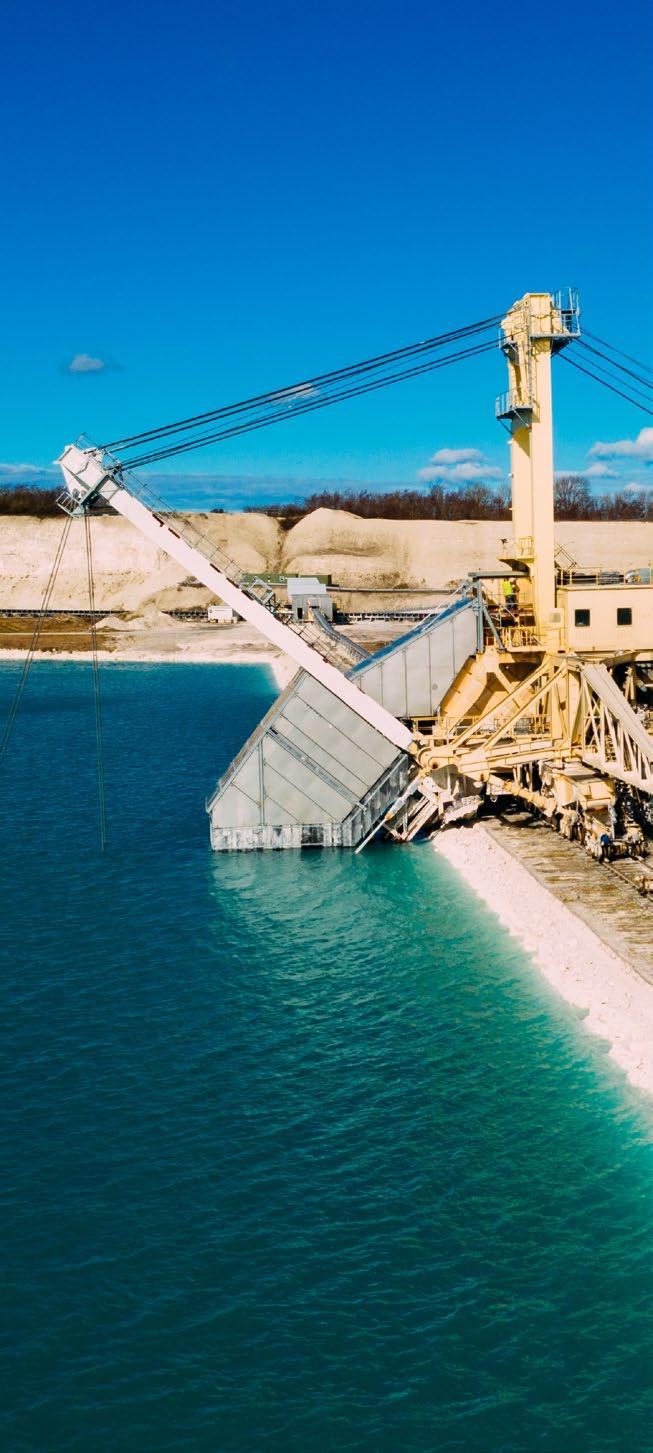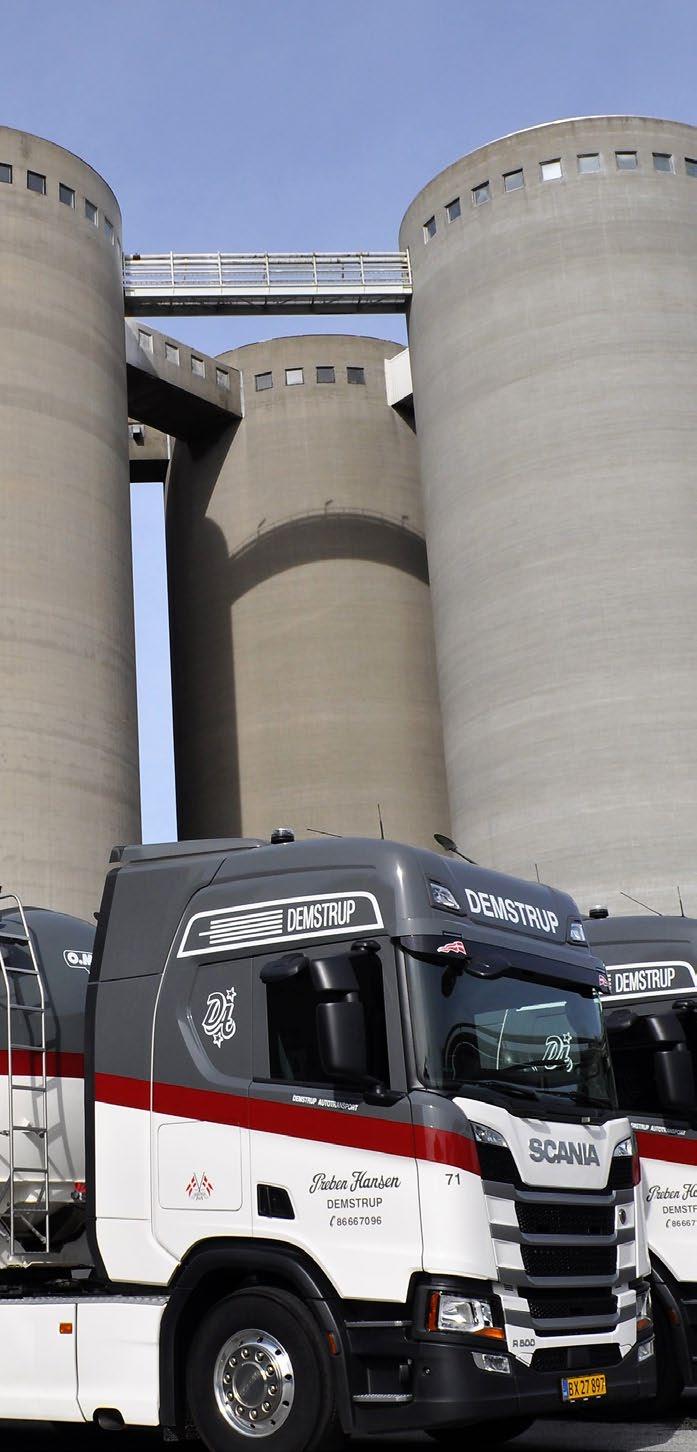
6 minute read
Greenhouse Gas Emissions
What we did in 2022
• Reduced Scope 1 GHG emissions by 11,9% compared to 2021
• Successfully tested new types of sustainable biomass fuels
Reduction of greenhouse gas emissions is by far the greatest and most urgent challenge of this decade. Cement shares the same inherent CO2 challenges no matter where it is produced.
There are two primary CO2 sources from cement production: heating of raw materials to 1,500°C through the burning of fuels and the release of CO2 naturally bound in chalk as it is heated. These two sources alone constitute more than 99% of our Scope 1 emissions. Therefore, our CO2 reduction strategy centres around reducing our direct air emissions from the chimneys. By reducing our Scope 1 emissions by 73% by 2030 compared to 2021, we ensure cement produced in Denmark will be amongst the world’s most sustainable by 2030, emitting around 300 kg of CO2 per tonnes on average. This reduction will significantly contribute to UN Sustainable Development Goal 13, “Climate Action”.
DIRECT GHG EMISSIONS (SCOPE 1)
In 2022, our Scope 1 emissions were 1,981,749 tonnes, representing a 11,9% decline compared to 2021. This emission reduction is an important step in our reduction strategy.
To reduce our Scope 1 emissions further, we work in three tracks: increase the share of alternative fuels, develop and market new low-carbon products and install a large-scale carbon capture facility.
• Continued work on critical infrastructure that will connect our plant to the gas distribution grid
• Inaugurated a new pilot facility for carbon capture
Planned for 2023
• Secure long contracts on new streams of alternative fuels
• Continue work to set up two wind turbines to deliver sustainable electricity to our plant
• Intensify reseach and development within CCUS
Relevant SDGs
Alternative fuels will deliver 40% of our CO2 reductions
The most significant initiative to reducing our Scope 1 emissions is to increase the share of alternative fuels when heating our cement kilns, instead of burning with traditional fossil fuels such as coal and petroleum coke. By 2030, we aim to replace coal and petroleum coke with alternative sources, delivering CO2 reductions of approximately 900,000 tonnes annually.
In 2022, we managed to increase the amount of thermal energy from alternative fuels from 28.0% to 30.2% in line with our ambitions for the year.
In the coming years, we will focus on increasing the share of nonrecyclable wastes and sustainable biomass in our fuel portfolio. This share will include refuse-derived fuels (RDFs) and various biogenic byproduct streams e.g., meat and bone meal, sawdust and wood chips. Likewise, we will introduce natural gas, which emits 40% less CO2 compared to coal and petroleum coke. Later, we will convert natural gas to biogas, which is carbon neutral. We have entered into an agreement with the Danish gas distribution company, Evida, to connect Aalborg Portland to the gas distribution grid.
Waste-to-energy in cement is key to circularity
As an energy-intensive industrial company, we can play a critical role in society’s circular economy by co-processing non-recyclable waste and biomass. By utilising these materials to fuel our cement production, we recover energy from materials that would otherwise be landfilled or incinerated, which is worse for the environment. In 2022, we reused more than 200,000 tonnes of non-recyclable waste and biomass. When we burn processed waste, we also emit carbon, just like burning waste at an incineration plant. However, incineration plants burn waste to produce electricity, causing residues that society must deal with. In our cement kilns, we burn waste that produces heat for calcination. The remaining residue becomes part of the end-product. Likewise, we can capture the fossil fractions of CO2 from burning the waste, storing it safely underground utilising carbon capture and storage. The biogenic fractions of CO2 (e.g. from waste biomass) can be used to produce green methanol, and waste heat from the carbon capture facility can deliver district heating to local communities, just as we do with waste heat from our cement kilns today.
Not only does co-processing lead to significant CO2 reductions from our cement production, but it also allows for a truly circular economy, where we recycle waste to reduce society’s dependency on imported fossil energy, safely dispose of residues and deliver sustainable energy to heat local communities.
Developing future cement in Aalborg
The second initiative to reduce our Scope 1 emissions is to reduce our cement’s clinker content, which requires extensive research and development (see more in the section “product innovation” on page 29). In 2022, we went to market with two new low-carbon products, and more will follow in the years to come.
By 2030, we expect that low-carbon cement developed in Aalborg will deliver carbon reductions of more than 300,000 tonnes per year, equivalent to 15% of our emissions in 2021.
We will capture at least 400,000 tonnes of CO2 per year
Chalk releases naturally bound carbon when it is calcined to produce cement clinker, and we cannot produce cement without chalk.
Therefore, carbon capture is inevitable to achieve sustainable cement production. Our ambition is to establish a large-scale carbon capture facility in our plant, capturing at least 400,000 tonnes of CO2 per year by 2030, equivalent to 18% of our emissions in 2021. The potential for carbon capture at Aalborg Portland is much higher than 400,000 tonnes and will play a critical role in reaching carbon neutrality by 2050 at the latest.
We already capture CO2 from our production
On 5 December 2022, we inaugurated the first carbon capture pilot facility in our plant. The pilot has been set up in collaboration with the Technical University of Denmark and with funding from Innovation Fund Denmark.
Large-scale carbon capture is still a very expensive technology. Society needs to develop new infrastructure between the CO2 source and point of use or storage to unlock its full potential. Therefore, we engage in various research projects to learn about the new technology, benefitting Aalborg Portland, the cement industry and society in the future.
INDIRECT GHG EMISSIONS (SCOPE 2)
Our Scope 2 emissions were 45,941 tonnes in 2022, primarily driven by the purchase of electricity to run our cement kilns and mills and to cover the plant’s base power load. Scope 2 emissions are not directly linked to cement production, as it reflects electricity needed to run the entire plant while also taking into account the renewable mix of the national power grid. Our main focus is on energy efficiency in existing production units which has led to new ideas and the launch of new energy saving projects.

Own production of renewable energy
In 2022, we consumed 330,253 megawatt-hours of electricity, making us one of the biggest power consumers in Denmark. The fact that we own more than 1,000 hectares of land surrounding our plant supports on-site power generation from renewables like wind and solar.
To support this transition, we work on setting up at least two wind turbines on our premises. These wind turbines will enable us to produce around 8% of our current electricity demand. The project is in collaboration with Eurowind Energy A/S. For more information, please see www.energiparkaalborg.dk.
INDIRECT GHG EMISSIONS (SCOPE 3)
Our Scope 3 emissions were 886,741 tonnes in 2022, representing indirect emissions occurring in our value chain, such as generation and transportation of raw materails and fuels, and distribution of finished products to our customers. Scope 3 emissions are therefore not directly linked to cement production. To reach carbon neutrality in our supply chain, we need to include CO2 emissions in all sourcing decisions and promote zero-emission transportation solutions within our supply network.
In 2022, the distribution of cement from Aalborg Portland included handling and transporting nearly 2.5m tonnes of product to the domestic and export markets. Our distribution of cement to export markets is limited to ship transport to terminals abroad. In contrast, we transport cement sold in Denmark via the sea and roads to Danish terminals. Distribution by ship mitigates road traffic, whilst ships have the advantage of being a more sustainable mode of transport due to the economics of scale. In 2022, 38% of our cement was distributed by road, 24% by ship, and 38% by a combination of road and ship.
reducing fuel consumption per tonne carried. Long-term, we believe the industry will shift towards new and more climate-friendly fuels. For distribution by road, our focus is to work with our carriers to find the right balance between fleets running on electricity for short-distance transportation and green carbonaceous fuels.
Carbon capture in decarbonizing heavy transport

We can produce carbonaceous fuels such as menthol by converting green hydrogen and carbon. However, we expect biogenic and sustainable carbon to become a limited resource in the future. Hence, we can play a vital role in decarbonising the shipping industry by capturing and utilising the biogenic fractions of CO2 in our flue gasses.
Other Air Emissions
Other air emissions from cement production are mainly SO2 and NOx emissions, which stood at 786 tonnes and 2,706 tonnes in 2022, respectively. SO2 is removed from flue gasses in white cement kilns using installed scrubbers, whereas the preheater tower on the grey cement kiln acts as a scrubber. NOx is removed by staged combustion in the white kilns, whereas a method of selective none catalytic reaction (SNCR), which involves the injection of ammonia into the flue gasses, removes NOx in the grey kiln.
Working with carriers to decarbonise transportation
For distribution by ship, our main short-term initiative is to work with freighters that can deliver our products using newer vessels, thereby








